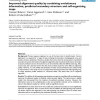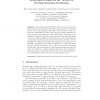37 search results - page 2 / 8 » Automated alphabet reduction method with evolutionary algori... |
BMCBI
2006
13 years 4 months ago
2006
Background: Protein sequence alignment is one of the basic tools in bioinformatics. Correct alignments are required for a range of tasks including the derivation of phylogenetic t...
BMCBI
2008
13 years 5 months ago
2008
Background: Protein-protein interactions are ubiquitous and essential for all cellular processes. High-resolution X-ray crystallographic structures of protein complexes can reveal...
EVOW
2012
Springer
12 years 16 days ago
2012
Springer
Abstract. The hydrophobic-polar (HP) model for protein structure preabstracts the fact that hydrophobic interactions are a dominant force in the protein folding process. This model...
RECOMB
2004
Springer
14 years 5 months ago
2004
Springer
In nature, one finds large collections of different protein sequences exhibiting roughly the same three-dimensional structure, and this observation underpins the study of structur...
BMCBI
2006
13 years 4 months ago
2006
Background: The accuracy of protein secondary structure prediction has been improving steadily towards the 88% estimated theoretical limit. There are two types of prediction algor...


